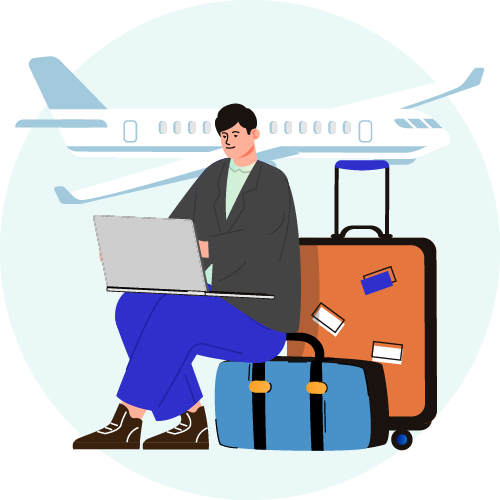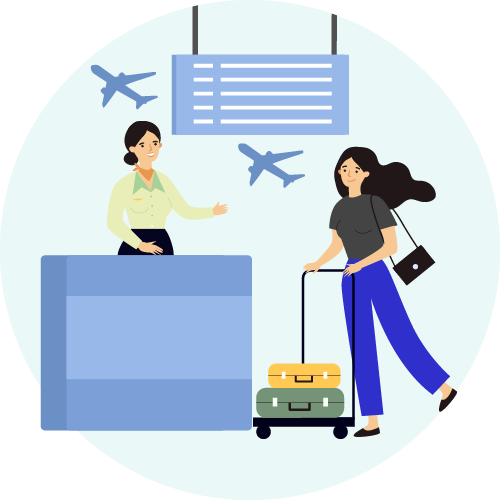- Travel restrictions are opening up and more people are flying again, but post-pandemic travel reveals the fragility of many airline networks amid labor shortage.
- New technology and travel styles are emerging as more travelers opt for relaxed ways of alternative travel and work.
- While leisure travel is increasing, business travel remains somewhat stagnant with many conferences remaining virtual and companies rethinking more cost-effective and safer ways of collaboration.
The US eased travel restrictions and reopened its borders to vaccinated foreign tourists on November 8 2021.
Following more than 18 months of border closures, people from the US and elsewhere are looking forward to embracing international travel again.
Travel companies are keeping an eye on increased interest in leisure travel this year and next year as borders reopen and vaccination rollouts continue to gather pace worldwide.
But what about business travel?
Has the success of Zoom put a kibosh on business travel for good?
Whether you think business travel will bounce back or has become an outmoded practice, one thing’s for certain: the future of business travel will look different to how it did before.
Impact of the pandemic on travel
The coronavirus pandemic sent countries around the world into lockdown, putting a temporary stop to non-essential travel.
Following strict lockdowns, mask mandates and increased sanitation have become the norm, as have flexible cancellation policies for flights and accommodation.
At the time of writing (Nov. 8), wearing a mask over your nose and mouth is required in indoor areas of public transport, including on airplanes, traveling into, within, or out of the United States and in indoor areas of transportation hubs such as airports.
Other rules also apply. You can find updated requirements and recommendations here.
Research conducted in January 2021 by Tourism Economics – focusing on a week-by-week outlook on travel spending in the US – revealed that travel spending amounted to just $679 billion in 2020, marking an unprecedented annual decline of 42% from 2019.
Perhaps unsurprisingly, it was international travel and business travel that experienced the steepest declines.
Spending on domestic travel within the US dropped by 34% while international travel spending dropped by 76%. Spending on leisure travel fell by 27% and business travel experienced a significant 70% decrease.
Now that borders are reopening again, experts are optimistic about the recovery of the leisure travel sector, as we’re about to find out.
But can the same be said for business travel?

When will travel return to normal?
In Expedia Group’s 2021 Travel Trends Report conducted in December 2020, 46% of survey respondents said they’d be more likely to travel once vaccines become widely available.
When the US Government announced that vaccinated travelers from abroad could enter the US from 8 November 2021, the travel booking site Skyscanner experienced an 800% spike in bookings the next day.
Expedia witnessed a 28% rise in searches for U. hotels from the UK. As well as international tourism, internet searches for outbound international from the US also rose.
Searches for outbound international travel on the booking app Hopper have risen by 24% since border closures ceased, the highest increase since the spring.
A Centre for Aviation (CAPA) and Collinson Report published in November 2021 sheds light on to what extent – and when – travel industry experts anticipate a return to “normal” 2019 levels of activity.
Despite the reopening of borders, 67% of c-suiters, executives and senior managers from airlines, airports, and aviation suppliers around the world don’t predict a return to “normal” until 2023 or later.
What about business travel?
CAPA’s survey respondents said they expect short-haul and leisure travel to recover quicker than business travel.
In short-haul business travel in APAC, for instance, just 35% of respondents forecast a solid recovery by 2022. Meanwhile, only 20% of executives surveyed were expecting a solid recovery for long-haul business flights by 2022.
This is understandable when you consider that longer-haul, international travel is more complex and subject to ever-changing government rules.
When it comes to business travel’s recovery, looking at stats around face-to-face meetings can help us figure out when it’s likely to pick up again.
In an iMeet Survey of Meeting Planners, 81% respondents believe it will take until 2023 to return to at least 80% of pre-COVID-19 annual event levels.
Before the pandemic, the summer vacation period was usually replaced with an uptick in business travel. Kids went back to school and businesses would once again look to meet with clients and generate new business.
The fall is also usually the time when trade shows and conventions take place. In fact, travel to conventions and trade shows typically comprise around 20% of all corporate travel.
Airlines, hotels, and restaurants in big conference cities like Las Vegas and Chicago would benefit from this annual boon in business travel.
But despite summer 2021 showing strength in terms of leisure travel, the same can’t be said for business travel this fall.
Many annual conferences have decided to stay online, and the likes of the New York Auto Show were cancelled due to an uptick in the COVID-19 Delta variant.
Some of the US’ biggest firms are even predicting a permanent drop in business travel.
In an interview with Harvard Business Review, Courtney Miller, managing director of analysis for The Air Current, contemplates a hybrid future for in-person business events:
The decline in business travel is having a huge impact on some US airlines, especially those that typically have the largest corporate travel revenue.
These airlines are having to re-strategize, with some taking a more leisure-focused approach.
What will business travel look like in the future?
Of course, we’re still in the transition period, so we can’t accurately predict what the future of business travel will look like. There are, however, a few emerging trends that we expect will feed into what business travel will look like in the short-to-medium term.
1. The rise of the “bleisure” trip

The rise of widespread remote working is paving the way for a new type of travel: “bleisure”.
Could it be the new face of business travel?
A blend of leisure and business, the bleisure trip is perfect for workers who have the financial and operational freedom to be able to work while traveling or backpacking.
The hotel chain Marriott has transformed some of its hotels into bleisure destinations through its “Work Anywhere” campaign, which enables travelers to book rooms for a day.
Some hotels are also offering longer-stay deals to entice those who can work from anywhere.
In Mauritius, Beachcomber Resorts & Hotels offers a 65% discount for long-term stays of at least two months, and Heritage Resorts offers two-month stays in a villa from £2,800 a month. Housekeeping, pool and garden maintenance and Wi-Fi are included in the package.
Governments are getting on board too.
In 2020, Barbados launched its 12-month Welcome Stamp visa. At $3,000 for a family, the programme establishes a visa to allow people to work remotely in Barbados for a maximum of 12 months. To be eligible, applicants must earn a minimum of $50,000 a year.

2. Non-traditional accommodation

Airbnb-style vacation rentals have proved popular during the Covid-19 pandemic because they satisfy travelers’ need for self-catered, independent space.
Unconventional accommodation is a growing business travel trend. Employers and employees are looking beyond hotel chains to spaces with a more “homely” feel.
Even before the pandemic, more than 70% of millennial corporate travelers had stayed in a vacation rental during business trips, according to 2019 data by American Express.
Business travelers are also choosing to stay in accommodation situated away from city centers as they prioritize comfort and proximity to leisure activities.
3. More flexibility, forever

Corporate travelers require flexibility, full stop.
Travel policies have become more flexible as a result of the pandemic, and experts predict airlines and accommodation providers will have to retain this flexibility moving forward in order to keep customers.
Last year, CNN revealed that the top 3 US airlines have decided to eliminate change fees for flights for all but the cheapest seats.
4. Technology to streamline the travel experience

As technology continues to evolve, business travelers are in for a smoother ride.
The majority of business travelers already benefit from automated check-in processes, allowing them to collect their room key when they arrive and go straight to their room.
Business commuters can now spend less time in airport queues owing to the rollout of facial recognition technology designed to accelerate border control.
Fingerprint and retinal scanning are also becoming more commonplace in airports.
Meanwhile, trip disruption technology is enabling people to subscribe to services that provide up-to-the-minute information about any changes to a journey directly to their mobile device, allowing them to plan ahead more effectively.
Finally, travel companies and mobile network operators are collaborating to introduce high-speed internet to flights. This will allow business travelers to maximise productivity on both short and long-haul flights.
Flexible workspaces for the future business traveler
You can’t talk about the future of work without mentioning flexibility.
Business travel can only recover if flexibility runs throughout the end-to-end commercial travel experience. And that’s where flexible workspaces come in.
Flexible workspaces allow people to sign up for a workspace on a monthly, weekly or even daily basis. For this reason, they’re set to play a huge role in business travel.
Large flexible workspace operators like WeWork have already adapted their membership options for the modern day business traveler.
For example, WeWork’s All Access Pass enables individuals or teams to access hot desks, conference rooms and private offices in hundreds of WeWork locations around the world.
Dozens more flexible workspace operators are offering similar options.
If you’re interested in signing up for a flexible workspace pass that facilitates domestic or international travel, visit Allwork.Space- Find Space to view the best available options.


 Dr. Gleb Tsipursky – The Office Whisperer
Dr. Gleb Tsipursky – The Office Whisperer Nirit Cohen – WorkFutures
Nirit Cohen – WorkFutures Angela Howard – Culture Expert
Angela Howard – Culture Expert Drew Jones – Design & Innovation
Drew Jones – Design & Innovation Jonathan Price – CRE & Flex Expert
Jonathan Price – CRE & Flex Expert














